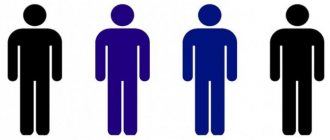Recently, I began to notice that there are more and more people around me who have an increasingly noticeable difference in development between “traditional” intelligence and “social” (or, if you prefer, emotional). But first things first.
In 1920, American psychologist Edward Lee Thorndike coined the term “social intelligence,” which describes the ability to correctly understand people's behavior. This ability, developed by humans as a result of evolution, is necessary for effective interaction between representatives of our race and the successful social adaptation of its new members.
In 1937, another American psychologist, Gordon Allport, author of the “personality trait theory,” associated social intelligence with the ability to make quick, almost automatic judgments about people and predict the most likely human reactions. In his opinion, “social intelligence” is a special gift that allows us to adapt to society and facilitates relationships with people.
May meticulous psychologists forgive me, but to social intelligence, in the context of our modern life, I would add another term - “emotional intelligence”. After all, the expression of emotions in the vast majority of cases is a social tool.
The social role of emotions is confirmed by the fact that facial expressions in people who are blind from birth are extremely poor.
The term emotional intelligence (EI), coined in 1990 by Peter Salovey and Jack Mayer, describes a person's ability to recognize emotions, determine their origin and role, generate and manage them for the sake of emotional and intellectual growth.
The EI coefficient, in contrast to the generally understood IQ, describes a person’s ability to correctly interpret the situation and influence it, intuitively grasp what other people want and need, understand their strengths and weaknesses, not give in to stress and be charming.
So, returning to the beginning of this article, many psychologists have recently come to the conclusion that the level of “general” intelligence does not correlate in any way with the level of social intelligence.
Sheldon Cooper, one of the main characters of The Big Bang Theory, is a classic example of a person with a high IQ (the number was 187 in the film) and low “social intelligence.”
A high intellectual level is a necessary, but by no means sufficient, condition for the social development of an individual, that is, it can help social development, but not replace it.
Moreover, high intelligence can be completely devalued if its owner suffers from “social blindness.”
Surely many of you have examples of how a smart guy (or girl), when communicating, behaves slightly inappropriately (does not fit into the “wave” on which everyone else is) and provokes a negative attitude towards himself.
Why, such “failures” have probably happened in the lives of each of us - a bad joke, inappropriate laughter, or any other situation from our unsuccessful social experience.
A person determined to increase his social intelligence will try to remember this situation in detail, disassemble it “piece by piece” (what happened “before”, what happened “after”, why this happened, how I really should have behaved, etc. ), in order to learn from the experience and not make these mistakes in the future.
The result of awareness of this event is fixed in the cognitive structures of the psyche in the form of skills, and the more a person has these skills, the easier it is for him to “belong” in society and achieve his own goals using those around him.
What is it: definition
Important. SQ is a set of abilities that influence the success of social interaction.
It consists of the ability to understand oneself and the behavior of other people, as well as the ability to act according to the situation, and is a very important quality, as it is necessary for effective interpersonal interaction.
The term was introduced to denote the ability to act successfully in society , to behave most effectively in any situation.
This is the ability to understand the mood of others and their personality traits, the ability to self-present in society and various interactions, a kind of talent that allows you to get along with people and adapt to the behavior of others in society. This global ability, based on a combination of other personality traits (intellectual, behavioral, communicative, etc.), determines the understanding of what people say and do, the ability to:
- social interaction;
- decision making;
- forecasting the development of events in interpersonal communication.
The personal component of social intelligence is quite large, but it can be corrected from the outside (special techniques and maximum training interaction).
You will learn about the year in which Thorndike introduced the term social intelligence and what is the history of the concept of SQ, as well as the definitions of this concept and approaches to understanding it, the relevance of the study today, methods of study and measurement, and research on SQ.
Development
It's never too late to improve. Therefore, everyone should know how to improve their social intelligence. If you at least occasionally do exercises and try to increase social development, then gradually it will reach a high level. To do this, it is necessary to positively influence all components of the SI:
- self-knowledge;
- self-regulation;
- sociality;
- empathy;
- motivation.
There are many ways in which SI can be developed. They should be put into practice regularly to achieve maximum effect.
There are also simple ways to increase social intelligence. For example, banal participation in board games with friends.
Nonverbal interaction
You should always pay attention to the actions of your interlocutor. This is especially true for his nonverbal signals. Any movement carries great meaning. To learn to understand them well, you should read a specialized book. A good training would be to watch a film without sound and independently determine the meaning of the characters’ movements. It is also important to manage your own non-verbal language to more accurately convey your emotions.
Self-confidence, communication
Much of improving social intelligence skills comes down to confidence and the ability to communicate. It is important to feel strong posture, your own strength, and forget about all the negativity. To do this, you can play sports, buy expensive clothes, etc. Also, regular communication with people has an effective effect on confidence if a person finds it difficult. Therefore, you should try to communicate with a large number of people, as well as regularly make new acquaintances. At the same time, you need to learn to listen, speak correctly, and observe your interlocutors.
If a person does not know how to refuse, then this can also be an excellent way to train. Every refusal is a contribution to development.
Thinking
Correct thinking is another way to develop social intelligence. There is no need to dwell on problems and your own mistakes. It is important to remember that the past cannot be changed. If you can correct the situation now, then you need to do it. In other cases, there is no need to think about it, because this causes nothing but negativity, negatively impacting communication skills and overall quality of life.
Emotional component
Controlling your own emotions, self-observation, and careful analysis is a good method to help improve social intelligence. To do this, you need to understand what causes what emotions, think about the reasons, and also learn to control them. If you can’t control them, then don’t be upset, because all methods require good training. At the same time, you need to try to reduce the number of negative emotions, increasing positive ones to the maximum.
But even more important is the ability to read other people's emotions. And not just read them, but at the same time empathize with people, showing empathy. Listen to them, try to show support. This will improve not only your social intelligence skills, but also your relationships with people. Good, understanding people are always appreciated by others.
Models of its structure and types
There are several approaches to the interpretation of social intelligence, which has given rise to several models of its structure:
- G. Eysenck.
- D. Guilford.
- G. Allport.
- F. Vernon.
- O.Konta.
- R. Sternberger.
- Yu. Emelyanova.
- V. Kunitsyna.
- F. Yuzhaninova.
The most common are several models, which will be discussed in more detail below.
Attention. SQ itself, in turn, is one of the types of general intelligence; it is knowledge and skills acquired in the process of socialization in combination with genetically determined abilities. This is a personality trait on which success in interpersonal interaction depends.
According to G. Eysenck
He believed that this type of intelligence is social in nature. It is formed during the socialization of a person. In his opinion, social intelligence can be distinguished as something separate that is based on biological and psychometric intelligence:
- The first is the entire set of innate abilities that allow one to act on the basis of received information in society. This is a basic aspect of social intelligence.
- The second acts as a link between the biological and the social. The main parameter influencing the level of this type of intelligence is the speed of information processing.
According to J. Guilford
D. Guilford understood SQ as a set of intellectual abilities associated with the knowledge of behavioral information. His model of intelligence contains three dozen abilities related to social intelligence. This is, first of all, understanding behavior, productive thinking in this direction and assessment. He emphasizes the importance of recognizing non-verbal language.
Important. D Guilford first approached the problem from a measurement point of view, developing a test to determine the level of intelligence.
Unlike Eysenck, he believed that SQ does not depend too much on general intelligence, but is related to the ability to work with behavioral information, which includes six aspects:
- ability to understand verbal and non-verbal behavior;
- recognize what is important in the flow of information;
- understand relationships, the logic of the development of situations, the meaning of people’s behavior.
According to G. Gardner
He proposed a structure of multiple intelligences that are directly related to social intelligence.
In his opinion, it is based on different abilities and skills suitable for survival in society.
Different people have different intellectual abilities in different combinations, and social intelligence acts as the ability to solve problems in society.
According to Gardner, there are several types of intelligence, and one does not depend on the other; they work in the brain and as independent modules:
- linguistic;
- musical;
- mathematical;
- verbal;
- kinesthetic;
- spatial;
- personal.
The latter, in turn, is divided into:
- intrapersonal (the ability to recognize one’s feelings, motives, etc.);
- interpersonal (the ability to recognize everything related to the behavior of other people).
What are the benefits of developed social intelligence?
Corresponding Member of the Russian Academy of Sciences, Doctor of Psychology Dmitry Ushakov writes Ushakov D.V. Social intelligence as a type of intelligence. Social intelligence: theory, measurement, research. M. 2004, that in the modern world the division of labor is increasingly growing, and therefore, individual achievements are increasingly turning into collective ones. And to achieve success today, it is no longer enough to just be a professional in your field. You also need to be able to maintain connections with people, promote your ideas in society, and not just create them. For example, not be afraid to put forward bold proposals and be able to explain complex things in simple words. In this regard, social intelligence becomes an important element of self-realization.
In effect, this means that the inability to maintain social contacts nullifies even the sharpest mind. Great examples of such personalities are Sheldon from The Big Bang Theory or Sherlock Holmes from Sherlock.
There is also Ushakov D.V. Social intelligence as a type of intelligence. Social intelligence: theory, measurement, research. M. 2004 opinion that the higher our level of social intelligence, the more objective we are in relation to ourselves and others.
Thus, a person with a high level of social intelligence is one who can Riggo ER What Is Social Intelligence? Why Does It Matter? Psychology Today maintains a conversation with anyone, is tactful and chooses words wisely, knows how to listen, understands formal and informal roles. He is also good at detecting the real motives of other people and “picking up clues” to different types of personalities.
People with developed social skills feel more confident, know what they want from life and are easier Ivanov A. A. Age-related aspects of social intelligence. Research in education endures life's blows. This is largely facilitated by the fact that they do not experience difficulties in communication and easily establish social connections.
Components
Important. All people do something, counting on the success of the activity; this largely determines the meaning and amount of effort expended. All actions in society depend on other people with whom interaction is necessary when moving towards achieving a goal.
This is what SQ is for, since problem solving is based on understanding human behavior and the ability to influence it.
Several groups of abilities that make up social intelligence have been identified:
- educational;
- emotional;
- behavioral.
They, in turn, also include several components:
- Cognitive. These are knowledge, memory, intuition, forecasting:
- Social knowledge. Knowledge about people, rules of communication, effective interaction.
- Social memory. Remembering names, events, faces, and what people did and said.
- Social intuition. Unconscious understanding of feelings, moods, motives and all other aspects of people's behavior.
- Social forecasting. Conscious prediction of everything related to human behavior.
- Emotional. These are expressiveness, empathy, self-regulation:
- Social expressiveness. We are talking about the degree and methods of manifestation of emotions and feelings, emotional sensitivity.
- Empathy. The ability to empathize, the ability to put oneself in the place of another.
- The ability to self-regulate. The ability to self-control and regulate emotions.
- Behavioral. This is perception, interaction, adaptation:
- Social perception. The ability to hear, see, feel and recognize other manifestations of behavior.
- Social interaction. Varying degrees of ability to communicate with people in society.
- Social adaptation. The skill or gift to adapt to circumstances and people.
Concept
Social intelligence (SI) is the ability to distinguish and understand the actions of all people. The concept also includes the skill of communicating with others, establishing long-term contacts with individuals, and easily finding a common language with all people. The normal level of its development allows a person to quickly adapt to society, interact correctly with people, and achieve their goals. Therefore, it is very important to always maintain it at a decent level.
The concept is often closely associated with emotional intelligence, which makes it easy to recognize the emotions, intentions or motivations of others. Many people tend to combine both intelligences into one. Nevertheless, the concept of social type is usually presented in one of three variants:
- A separate type of mind. One of the components of a cognitive skill. Directly related to mathematical and verbal intelligence.
- Skills, knowledge, attitudes. Everything that was acquired by a person during socialization in society.
- Personal trait. A feature of human character on which the future depends, including communication skills.
Any of the three views on the concept is correct. They can even be combined, which allows us to create a clearer picture in understanding the phenomenon.
Future self-realization depends on the level of development of such intelligence.
Functions
- Communication-value is associated with the ability to communicate, understand (not only others, but also oneself), and assimilate the norms of relationships.
- Cognitive-evaluative is the ability to achieve a goal with the help of received information through cognition and assessment of situations and people's behavior.
- Reflective-corrective ensures making changes in the interaction process in order to obtain the desired result, helps to understand the perception of others.
Age characteristics
With age, it does not undergo significant changes, unlike the general one, but at the initial stage of life (childhood, adolescence) they are significant:
- In childhood, SQ develops through observation of the environment, adults with developed social intelligence, as well as during games and when communicating with peers.
- During adolescence , the communication aspect, the ability to understand oneself and others, forecasting, etc. develop most actively.
- In adults, the development of social intelligence is enriched by experience and takes the form of wisdom.
Read about age-related changes, gender differences, and the impact on the competence of judgments here.
A new approach to the problem of social intelligence
Social intelligence and social competence
History of the development of ideas about social intelligence
Social intelligence is a relatively new concept for social psychology, which is in the process of development and clarification of verification.
The concept of “social intelligence” was first used in 1920 by E. Thorndike, denoting foresight in interpersonal relationships and equating it with the ability to act wisely in human relationships.
According to E. Thorndike, there are three types of intelligence:
1) abstract intelligence as the ability to understand abstract verbal and mathematical symbols. and perform any actions with them;
2) specific intelligence as the ability to understand things and objects of the material world and perform any actions with them;
3) social intelligence as the ability to understand people and the ability to interact with them.
In 1937, G. Allport describes social intelligence as the special ability to correctly judge people, predict their behavior and ensure adequate adaptation in interpersonal interactions.
In the 1960s, works appeared on social skills and communicative competence. During these years, much attention is paid to the problem of social perception, people’s understanding of each other; An attempt is made to develop, on the basis of established conceptual ideas about the nature and structure of social intelligence, a methodological apparatus for its study. J. Guilford and M. Sullivan develop a test for social intelligence research, which is widely used in specific studies, despite the presence of certain shortcomings. In the 1980s, D. Keating created a test to assess moral or ethical thinking. M. Ford and M. Tisak based the measurement of intelligence on the successful solution of problem situations. They were able to show that social intelligence represents a distinct and coherent group of mental abilities associated with the processing of social information, a group of abilities that are fundamentally different from the abilities that underlie the more “formal” thinking tested by “academic intelligence” tests.
In 1981, R. Sternberg conducted a study aimed at studying the ideas of ordinary people about social intelligence. The results of the study showed that people understand the following in the concept of social intelligence:
- the ability to solve practical problems (a person thinks logically and sensibly, sees all aspects of the problem; makes good decisions; turns to original sources of important information; listens to all arguments, etc.);
- verbal ability (speaks clearly and with clear articulation; understands what is read well; has a good vocabulary; communicates effectively with people, etc.);
- social competence (accepts others as they are; is not late for meetings; is sensitive to the needs and desires of other people; makes fair judgments, etc.).
Social intelligence is often equated with wisdom.
In 1987, N. Cantor’s book “Personality and Social Intelligence” was published, in which the author equates social intelligence with cognitive competence, which allows people to perceive the events of social life with a minimum of surprises and maximum personal benefit. Kantor N. considers social intelligence from the perspective of cognitivism.
The works available in Russian psychology touch on the problem of social intelligence mainly in the aspect of communicative competence, and also describe the supposed structure and functions of social intelligence. For the first time, an attempt to define social intelligence was proposed by Yu.N. Emelyanov, closely linking it with the concept of “social sensitivity”. He believed that on the basis of intuition, a person develops individual “heuristics” that a person uses to make inferences and conclusions regarding interpersonal interaction. They have reliability and sufficient prognostic effect.
Aminov N.A. and Molokanov M.V. in 1992, they studied the connection between social intelligence and a person’s professional orientation. The authors are convinced that the professionalism of a psychologist depends on the presence of special abilities, in particular social intelligence.
In 1994 N.A. Kudryavtseva proposed a conceptual development in which she correlated general and social intelligence, and showed that social intelligence is relatively independent in relation to general intelligence. N. A. Kudryavtseva, based on ideas about the structure of intellectual potential, developed a set of research approaches and specific techniques, which ultimately led to the identification of an integrative indicator of a person’s intellectual potential. It was designated as “unity of intelligence” and reflected the essential components of the mechanism of intellectual growth, increasing the coincidence of personality levels: general intelligence (the ability to solve problems at the subject-object level), social intelligence (the ability to solve problems at the subject-subject level), reflection ( the indicator captures the balance of development of different aspects of intelligence). An important component in the structure of social intelligence is a person’s self-esteem.
Social intelligence was thus understood as the ability for rational, mental operations, the object of which are processes of interpersonal interaction. At the same time, psychological autonomy and independence of the subject are assumed, allowing them to withstand the pressure of people and circumstances.
A new approach to the problem of social intelligence
Beginning in 1991, V.N. was developed. Kunitsina’s new concept of social intelligence, which highlighted a separate aspect of social intelligence – communicative and personal potential.
Social intelligence is a multidimensional, complex structure that has the following aspects:
1. Communication and personal potential
– a set of properties that facilitate or hinder communication, on the basis of which such integral communicative properties as psychological contact and communicative compatibility are formed; this is the main core of social intelligence.
2. Characteristics of self-awareness
– a sense of self-respect, freedom from complexes, prejudices, suppressed impulses, openness to new ideas.
3. Social perception,
social thinking, social imagination, social representation, the ability to understand and model social phenomena, understand people and their motives.
4. Energy characteristics:
mental and physical endurance, activity, low exhaustion.
Personal limitations play an important role in social intelligence, i.e. The personal component is quite large.
Social intelligence is a global ability that arises on the basis of a complex of intellectual, personal, communicative and behavioral traits, including the level of energy supply of self-regulation processes; these traits determine the prediction of the development of interpersonal situations, interpretation of information and behavior, readiness for social interaction and decision making.
Main functions of social intelligence:
— ensuring adequacy and adaptability in changing conditions;
— formation of a program and plans for successful interaction in tactical and strategic directions, solving current problems;
— planning interpersonal events and forecasting their development;
— motivational function;
- mobilization function, helping to overcome sudden crises, prolonged stress, situations that threaten self-esteem;
— expansion of social competence;
- self-development, self-knowledge, self-education.
Thus, social intelligence is individual inclinations, abilities, and properties that facilitate the development in personal experience of skills and abilities of social actions and contacts. Social intelligence helps a person predict the development of interpersonal events, sharpens intuition, foresight, and provides psychological endurance. A distinctive characteristic and sign of a person with a high level of social intelligence is sufficient social competence.
Content and structure of social competence
In conditions of drastic social changes, great demands are placed on the rapid development of new social knowledge and skills, and the expansion of social competence. To date, there has not yet been a final definition of social competence. M. Argyle in his book “Psychology of Interpersonal Behavior” pays attention to the concept of “general social competence”, combining professional and communicative competence with it. K. Rubin and L. Rose-Crasnor introduce the concept of social scenarios into the model of social competence, i.e. certain patterns, coordinated actions in well-known situations. German scientists W. Pfingsten and R. Hintsch define social competence as the possession of cognitive, emotional and motor modes of behavior, which in certain social situations lead to a long-term favorable ratio of positive and negative consequences.
In the work of E.V. Koblyanskaya (St. Petersburg), social competence is considered as an adaptation phenomenon, the basis of which is socio-psychological preparedness and communicative competence. Social competence, according to the author, is the ability to choose social guidelines and the ability to organize one’s activities in accordance with these guidelines.
V.N. Kunitsyna offers the following definition of social competence.
Social competence is a system of knowledge about social reality and oneself, a system of complex social skills and interaction skills, behavior scenarios in typical situations that allow one to quickly and adequately adapt, make decisions competently, taking into account the current situation; acting on the principle of “here, now and in the best possible way,” to extract the maximum possible from the current circumstances.
Social competence is an operational concept that has a time and historical framework. The key to successful human functioning in changing social circumstances is the development of behavioral scenarios that meet the new social reality and are expected by interaction partners.
Main functions of social competence:
■ social orientation of the individual;
■ adaptation to changing conditions;
■ integration of general social and personal experience.
Based on the limited foreign and domestic literature and domestic research, the following structure of social competence is proposed:
1. Operational social competence
– knowledge about social institutions and structures, their representatives in society; an idea of the functioning of social groups, modern conditions, the breadth and requirements of the modern repertoire of role behavior, general social orientation and awareness are measured.
2. Verbal competence
– appropriateness of statements, taking into account the context and subtext of the statement, absence of difficulties in written speech, variability in the interpretation of information, good orientation in the field of evaluative stereotypes and patterns, etc.
3. Communication competence
– possession of complex communication skills and abilities, the formation of adequate skills in new social structures, knowledge of cultural norms and restrictions in communication, knowledge of communication, traditions, etiquette in the field of communication, observance of decency, good manners, mastering the role repertoire within the framework of a given profession.
4. Socio-psychological competence
– interpersonal orientation; understanding of the diversity of social roles and methods of interaction, the ability to solve interpersonal problems; developed scenarios of behavior in complex, conflict situations.
5. Ego-competence - awareness of one’s national, gender, class, group affiliation, knowledge of one’s strengths and weaknesses, one’s capabilities and resources, understanding of the reasons for one’s mistakes and mistakes, knowledge of self-regulation mechanisms and the ability to use them, practical psychological knowledge about themselves, acquired through life experience.
The relationship between social intelligence and social competence.
Social intelligence and social competence at high levels of development are manifested in such essential properties for a mature personality as adequacy, autonomy, and authenticity.
Social intelligence acts as a means of cognition of social reality, social competence as a product of this cognition.
Social intelligence and social competence have in common that:
— they provide the opportunity to adequately adapt to social changes;
— they ensure the correct assessment of the situation, the adoption and execution of error-free decisions;
- they have quantitative characteristics, levels, and can be measured.
The difference lies in functions, mechanisms, content characteristics and methods of improvement. Social competence is improved through learning, expanding knowledge and experience, training and coaching, partly through psychotherapy. Social intelligence develops through the formation of socially desirable personal and communicative properties, improvement of the mechanisms of mental regulation, self-control and self-regulation, which increase stress resistance; many barriers and difficulties are removed thanks to auto-training.
In real human behavior, social intelligence and social competence are integrated, complementary and mutually dependent.
References 1. Aminov N.A., Molokanov M.V. On the components of special abilities of future school psychologists // Psychological Journal. – 1992, No. 5 – P. 104. 2. Kunitsina V.N. , Kazarinova N.V. , Pogolsha V.M. Interpersonal communication. Textbook for universities. – St. Petersburg: Peter, 2001. 3. Mel Yu. Social competence as the goal of psychotherapy: problems of self-image in a situation of social turning point // Questions of psychology. – 1995, No. 5 – P. 61-68. 4. Petrovskaya L.A. Competence in communication. – M., 1989.
How to develop skills?
Important. Skill development begins in the first year of life and continues into adulthood.
Then, from time to time, the formed social intelligence is adjusted in connection with current events.
Formation of SQ
Initial formation occurs in the family, then the influence of friends, relatives, preschool institutions, schools is added, then educational institutions plus the environment that accompanies each stage.
Periods of development
There are five stages of development. At the zero stage (presocial), the child is not aware of the differences, but gradually he begins to separate emotions, the feelings of others and his own:
- at the first stage, the ability to analyze words and behavior develops;
- on the second - empathic abilities, attempts occur to influence people and situations;
- on the third - there is an understanding of the inconsistency of people's behavior;
- on the fourth – the idea of human interaction is structured;
- on the fifth, skills are honed.
We talked about the formation, developmental features, methods of diagnosis and research and adaptation of children with disabilities here.
Levels
There are three levels: high, medium, low.
- In the first case, this means that the person has high skill in communicating and managing people, and controlling situations.
- In the second - patterned behavior, an average level of skills and knowledge necessary for successful interaction in society.
- In the third - destructive behavior, low efficiency, poor recognition of people's behavior.
SQ measurement problems
The first test to measure SQ was created by T. Khan. Later, the D. Guilford test appeared, which is still used today.
Attention. It must be said that tests are not an accurate assessment of this type of intelligence; today there are no ways to fully “measure” it.
Techniques
Recommendations for SQ development include special techniques. The most effective methods for increasing your SQ level include:
- empathy training;
- analysis of human behavior in videos/films;
- replaying situations;
- development of non-verbal skills;
- role-playing games.
It is necessary to develop abilities such as:
- memory;
- oratory;
- attention;
- analytics, etc.
General self-development will automatically have a positive effect on your SQ level.
Conditions
At the presocial stage, it is necessary to help the child achieve success in terms of separating the thoughts and feelings of other people from his own, and developing an interest in social interaction.
- At the first stage, it is necessary to pay attention to the development of subjectivism, to teach us to understand, first of all, ourselves, and only then those around us.
- At the second and third stages, you should pay attention to the ability to reflect, analyze the behavior and words of others, the ability to take the position of another, and cooperation.
- At the fourth stage, you need to continue to improve your skills and begin training that allows you to successfully interact in society (more practice).
What should you do to improve your social intelligence?
Can social intelligence be called a gift, or is it an acquired personality trait? It's difficult to answer. It is worth saying that everything must be taken into account: from temperament and character to individual qualities of a person. Is it necessary to develop social intelligence? The answer is obvious.
We suggest you figure out what exactly is important to focus on in order to become truly socially intelligent:
read books
They broaden your horizons and provide space for thought and imagination. You can tell a book lover from someone who doesn’t read after a few minutes of conversation. The more a person reads, the more interesting topics of conversation he can support, the more authority he gains in the eyes of his interlocutor.
Always speak in a positive way
People are drawn to those who create a situation of success for them. It is a fact. Everywhere, try to find the positive side in any situation, even if it seems catastrophically terrible. Instill faith in the best in your team, find the positives in each person and draw that person’s attention to them. Those. Give compliments, but without excessive flattery. Do it easily and from the heart.
Watch people
Watch how people behave on the subway (how they dress, what their facial expressions are), in line (what they buy, how they communicate with the cashier) and in any other place. The images of these people will be remembered in your memory, you will know approximately how this or that type can behave. Of course, it will take a lot of time to identify patterns in people’s behavior, but then you yourself will guess how a person, even a stranger, will react to a particular situation.
Develop a sense of humor
Firstly, know how to laugh at yourself and your mistakes. The main thing is that the jokes are kind, without blackness. And, by the way, don’t be afraid to play with facial expressions, let it be different for the interlocutor, then he will be interested in listening to you. Everyone has long been tired of the pursuit of so-called solidity and seriousness; it is boring and joyless.
“Catch” your facial expression throughout the day
When we get ready for work or school, we always look in the mirror when we leave. Most make their facial expression the way they ideally imagine it: smiling, flirtatious, friendly. And as soon as we leave the threshold, we are already in a hurry somewhere, a hard day is ahead, and it seems that the pretty face disappears somewhere on its own, replaced by frowning eyebrows and tightly compressed lips. What to do?
“Catch” your facial expression: as soon as you are lost in thoughts or immersed in work, or talking with someone on the phone (it doesn’t matter when), try to capture the facial expression as it was without your control. The likelihood that it will be extremely serious and gloomy is high. Ask yourself why?
Every morning before going out, we see in the mirror “the one” we would like to show to the whole world, but in reality this world sees us as a gray cloud. You don’t have to force yourself to put on a smile all day; it’s enough to just relax your face and slightly raise the corners of your lips.
Be active in dialogues
Any dialogue will be successful if two interlocutors are included in it. Here we are talking not only about actively telling something, but also about actively listening and hearing. Those. look directly into the eyes of your interlocutor, ask him questions on the topic, try to understand how he views the situation.
It is clear that few people will be pleased to see a person during a conversation who is scrolling through his VK feed and does not show any empathy.
Develop your acting skills
This is a sore subject for many. For some it is convenient to remain in the shadows, for others they see no point in demonstrating themselves, and for others this is a real reason for sadness, if only it weren’t for this embarrassment! Remember that speaking in public is not so scary. Most of the audience simply sits in their thoughts, only pretending to listen attentively.
Believe that first of all, by leaving your comfort zone, you develop yourself as a person. Your emotional and volitional sphere is developing. If you are really nervous before a speech, there is a simple but effective piece of advice: don’t look at those listening, don’t fix your gaze on anyone. Imagine that there is no one.
Be the master of your negative emotions
It is very difficult, sometimes unbearable, to control anger, anger, envy and much more. Very often these emotions and feelings are subconscious, we feel them, but not everyone can transfer them into a conscious understanding of the problem. When you feel overwhelmed, say out loud what is bothering you. If you are angry, ask yourself what exactly? Why do I react this way? Can this be fixed?
If you envy, for example, a friend, admit: “Yes, I am jealous, yes, I also wanted to have what she has.” By being aware of the problem, you do not allow it to settle in the depths. Otherwise, the unprocessed situation will “gnaw” at you like a small worm.
Be tactful
Try not to interrupt your interlocutor, give him the opportunity to say what he wants. Here we are talking not so much about the rules of etiquette, but about a feeling that allows you to understand what to say, how to say it and where. This also includes the rules of subordination.
* * *
Today, when personal success directly depends on interaction with people, it is very important to develop social intelligence. It’s good when parents initially brought up in their child everything that was mentioned in the article, but even if this is not your situation, don’t be afraid to work on yourself, don’t be afraid to change. And remember: as soon as your consciousness and train of thought changes, the world around you will immediately change!










